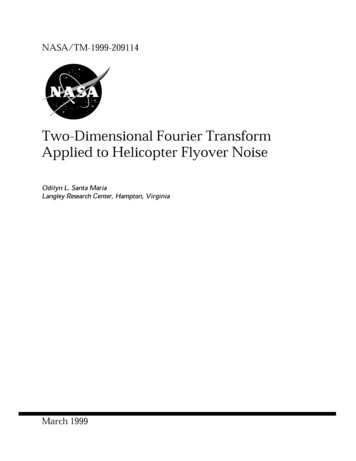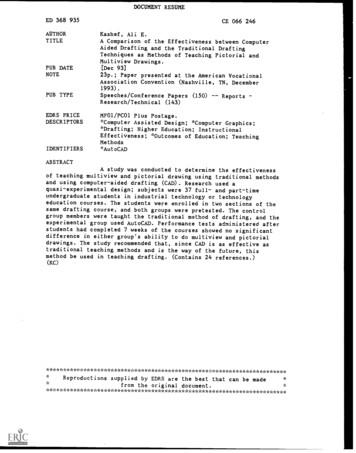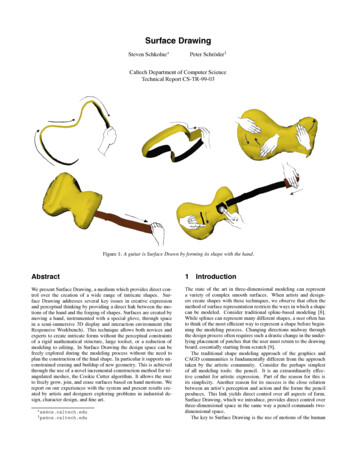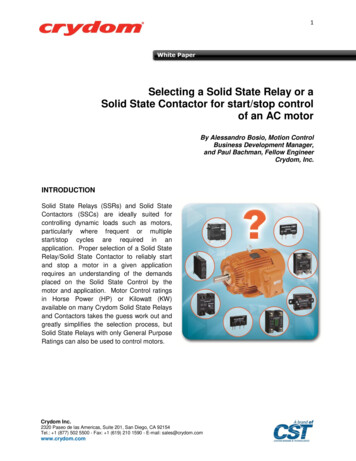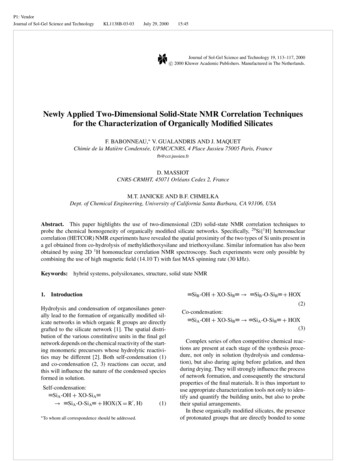
Transcription
P1: VendorJournal of Sol-Gel Science and TechnologyKL1138B-03-03July 29, 200015:45Journal of Sol-Gel Science and Technology 19, 113–117, 2000c 2000 Kluwer Academic Publishers. Manufactured in The Netherlands. Newly Applied Two-Dimensional Solid-State NMR Correlation Techniquesfor the Characterization of Organically Modified SilicatesF. BABONNEAU, V. GUALANDRIS AND J. MAQUETChimie de la Matière Condensée, UPMC/CNRS, 4 Place Jussieu 75005 Paris, Francefb@ccr.jussieu.frD. MASSIOTCNRS-CRMHT, 45071 Orléans Cedex 2, FranceM.T. JANICKE AND B.F. CHMELKADept. of Chemical Engineering, University of California Santa Barbara, CA 93106, USAAbstract. This paper highlights the use of two-dimensional (2D) solid-state NMR correlation techniques toprobe the chemical homogeneity of organically modified silicate networks. Specifically, 29 Si{1 H} heteronuclearcorrelation (HETCOR) NMR experiments have revealed the spatial proximity of the two types of Si units present ina gel obtained from co-hydrolysis of methyldiethoxysilane and triethoxysilane. Similar information has also beenobtained by using 2D 1 H homonuclear correlation NMR spectroscopy. Such experiments were only possible bycombining the use of high magnetic field (14.10 T) with fast MAS spinning rate (30 kHz).Keywords:1.hybrid systems, polysiloxanes, structure, solid state NMRSiB -OH XO-SiBIntroductionHydrolysis and condensation of organosilanes generally lead to the formation of organically modified silicate networks in which organic R groups are directlygrafted to the silicate network [1]. The spatial distribution of the various constitutive units in the final gelnetwork depends on the chemical reactivity of the starting monomeric precursors whose hydrolytic reactivities may be different [2]. Both self-condensation (1)and co-condensation (2, 3) reactions can occur, andthis will influence the nature of the condensed speciesformed in solution.Self-condensation:SiA -OH XO-SiA SiA -O-SiA HOX(X R0 , H) Towhom all correspondence should be addressed.(1) SiB -O-SiB HOX(2)Co-condensation:SiA -OH XO-SiB SiA -O-SiB HOX(3)Complex series of often competitive chemical reactions are present at each stage of the synthesis procedure, not only in solution (hydrolysis and condensation), but also during aging before gelation, and thenduring drying. They will strongly influence the processof network formation, and consequently the structuralproperties of the final materials. It is thus important touse appropriate characterization tools not only to identify and quantify the building units, but also to probetheir spatial arrangements.In these organically modified silicates, the presenceof protonated groups that are directly bonded to some
P1: VendorJournal of Sol-Gel Science and Technology114KL1138B-03-03July 29, 2000Babonneau et al.Si atoms makes the use of 29 Si{1 H} cross-polarization(CP) technique very valuable. Based on magnetizationtransfer between abundant and rare spins (here 1 H and29Si respectively), this technique has been often combined with MAS and high power proton decoupling toincrease the sensitivity of dilute nuclei [3]. The efficiency of magnetization transfer, which occurs duringthe contact time tc , is directly related to the 29 Si-1 Hdipolar coupling strength and thus to the 29 Si-1 H distances and mobility. Study of the polarization transferdynamics can thus provide structural information aboutthe proton environment of each detected Si sites.But, the main difficulty encountered in the onedimensional (1D) CP experiment is the uncertain nature of the protons that are the actual sources of themagnetization that is transferred, which interferes withconclusions concerning the spatial proximities between1H and 29 Si nuclei. The use of two-dimensional (2D)29Si{1 H} CP-MAS heteronuclear (HETCOR) NMR experiment can, however, circumvent this problem. Thistechnique was first introduced to characterize surfacespecies on silica and zeolite [4] and has also beenapplied to two siloxane-silica systems prepared frommethyltriethoxysilane (MTES) and tetraethoxysilane(TEOS) [5] and phenyltriethoxysilane (PhTES) andtetraethoxysilane (TEOS) [6]. In these examples, onlyone contact time, tc , was used for each system. But,indeed, tc can be used as a parameter to probe the spatial proximity between the protons and the various 29 Sisites.This paper will present results obtained with 2D29Si{1 H} HETCOR MAS NMR experiments, as wellas 2D 1 H homonuclear correlation MAS NMR experiments, to probe the chemical homogeneity ofhybrid networks prepared by co-hydrolysis of methydiethoxysilane and triethoxysilane.2.15:45ExperimentalAll chemicals have been used as received. The gelwas prepared by co-hydrolyzing methyldiethoxysilane((CH3 )HSi(OEt)2 ) and triethoxysilane HSi(OEt)3 ina 1/1 ratio under acidic conditions (EtOH/Si 2;H2 O/OEt 1; pH 2(HCl)). The resulting solutionwas aged in closed tubes at 60 C for 24 h, during whichgelation occurred. Then, the gel was dried at 100 C forseveral days. The notation TH and DH will be used respectively for the CH3 HSiO2 and HSiO3 sites and thegel will be labeled TH DH 1.The 2D 229 Si{1 H} heteronuclear correlation MASNMR experiments were recorded on a BrukerMSL-300 spectrometer (7.05 T) and a ChemagneticsCMX-500 spectrometer (11.75 T). TPPI was used forphase sensitivity with a 3-s repetition time and 128individual experiments with 8 to 48 acquisitions. The1H MAS-NMR experiments were recorded on a BrukerDRX600 spectrometer (14.10 T) equipped with a highspeed MAS probe-head (2.5 mm zirconia rotors), capable of spinning up to 35 kHz. The 1D 1 H spectra wererecorded with 125-kHz spectral width, 1-s recycle delay and 2.75-µs 90 pulses. For the 2D experiments,16 acquisitions with a 10-kHz spectral width and 2-sdelay were recorded for each of the 128 t1 experiments.3.3.1.Results1H-29 Si Heteronuclear Correlation (HETCOR)MAS NMR ExperimentsFigure 1 shows 2D 29 Si{1 H} HETCOR MAS NMRspectra which were obtained for the TH DH 1 gel fortwo different tc values. In the 1 H dimension, two signals are present due to Si-CH3 (δ 0.2 ppm) and Si-H(δ 4.6 ppm) species, and in the 29 Si dimension, thetwo peaks are characteristic of DH (δ 35 ppm) andTH units (δ 85 ppm). At short tc ( 50 µs), correlations are observed only between the two types of 29 Siunits and the Si-H proton species, indicating that thepolarization transfer to 29 Si nuclei occurs only fromthe directly bonded 1 H nuclei. For longer tc values(e.g. 3 ms), correlations are observed not only between the Si-CH3 groups and the DH units, but alsobetween these methyl protons and the TH moieties.Analysis of the intensity variations of these correlationpeaks with tc (Fig. 2) allow the extraction of associatedcross-relaxation TIS times, which are characteristic ofthe respective 29 Si-1 H dipolar coupling strengths. Asexpected, the values corresponding to dipolar interactions between the Si-H protons and the two 29 Si sites aresimilar (ca. 100 µs). Interestingly, the cross-relaxationtimes associated with the dipolar interactions betweenthe Si-CH3 protons and the two types of Si units arealso similar (ca. 1.5 ms); this suggests a close spatialproximity between the DH and TH units.3.2.2D 1 H Homonuclear Correlation MASNMR ExperimentsAnother way to probe the proximity of the two 29 Si sitesis to record a 2D 1 H homonuclear correlation MASNMR spectrum, to see whether 1 H magnetization can
P1: VendorJournal of Sol-Gel Science and TechnologyKL1138B-03-03July 29, 200015:45Newly Applied Two-Dimensional Solid-State NMR Correlation TechniquesFigure 1.3 ms.1152D 29 Si{1 H} heteronuclear correlation MAS NMR spectra (contour plot) of TH DH 1 gel recorded for two contact times: 300 µs andFigure 2. Variation, with contact time, of the intensity of the correlation peaks observed in the 2D 29 Si{1 H} HETCOR experiments.be transferred between different proton species [7, 8].This kind of experiment requires high resolution 1 HNMR spectra in order to distinguish the various proton sources. However solid-state 1 H NMR spectra areknown to usually have relative poor resolution whenusing simple experimental conditions, due to strong homogeneous broadening from homonuclear dipolar interactions that are only partially averaged by MAS [9].Multiple-pulse sequences combined with MAS havethus been developed to obtain better resolved spectra [10]. Using the combination of both high magneticfields (14.1 to 18.8 T) and fast MAS spinning rates (upto 35 kHz), it is possible similarly to obtain large improvements in spectral resolution. For example, comparison of Fig. 3(a) and (b) illustrates the effect of magnetic field strength on the resolution of a 1 H MAS-NMRspectrum of the TH DH 1 gel. At 14.10 T, two distinctsignals are visible at 4.4 ppm and 4.8 ppm due to SiHgroups in TH and DH units respectively with corresponding Full-Width-at-Half-Maximum (FWHM) of220 and 185 Hz. A faster spinning rate of 30 kHz(Fig. 3(c)) produces still better resolution with respective FWHMs of 175 and 120 Hz. At 14.10 T and 30 kHz,2D 1 H homonuclear correlation spectra were recordedfor different mixing times (Fig. 4), during which magnetization transfer may occur between the various proton species. Cross-peaks are not visible for short mixingtimes (tm 1 ms), indicating that for this time scale,the SiH and CH3 groups can be considered to be isolated. The residual dipolar couplings, if any, between
P1: VendorJournal of Sol-Gel Science and Technology116KL1138B-03-03July 29, 200015:45Babonneau et al.these species may lead to 1 H magnetization exchange atlonger mixing times. Indeed, cross peaks between thetwo types of SiH groups start to appear at tm 5 mswhile cross-peaks between each SiH type and the CH3species are only present for tm 100 ms (Fig. 4). Interestingly, 1 H magnetization transfer is more efficientbetween SiH groups belonging to the two differenttypes of Si units, rather than between the SiH and CH3groups which belong to the same Si unit (DH ). Thepresence of cross-peaks between the two SiH groups atshort mixing times strongly suggests the existence ofmixed domains in which the two Si units are in closecontact.4.Figure 3. 1 H MAS-NMR spectra of a gel prepared from cohydrolysis of MDES and TREOS in a 1/1 ratio.Figure 4.ConclusionsThe solid-state 2D 29 Si{1 H} heteronuclear correlationNMR experiments as well as the 2D 1 H homonuclear correlation experiments can provide new insightson the structural proximity of different Si species insol-gel derived siloxane-based materials. The information contents of such measurements are improvedunder conditions of high magnetic fields and fastMAS spinning rates. For a gel prepared from cohydrolysis of methyldiethoxysilane and triethoxysilane, the 2D 29 Si{1 H} heteronuclear correlation experiments recorded with variable contact time and the 2D2D 1 H homonuclear correlation MAS NMR spectra of TH DH 1 gel recorded with mixing times of 5 and 500 ms.
P1: VendorJournal of Sol-Gel Science and TechnologyKL1138B-03-03July 29, 200015:45Newly Applied Two-Dimensional Solid-State NMR Correlation Techniques1H homonuclear correlation experiments recorded withdifferent mixing times have shown that the two typesof silane units (CH3 HSiO and HSiO1.5 ) are in closedipolar contact, indicating chemically homogeneousnetwork.AcknowledgmentsThis research is supported by the European Community TMR program (“Oxycarbide glasses” network).FB and BFC would like to acknowledge the CNRSand the U.S. National Science division of InternationalPrograms (Grant # INT-9726744) for a collaborativeexchange program. FB and DM are grateful to Prof. G.Bodenhausen (Ecole Normale Supérieure, Paris) whomade possible the 1 H experiments on the 600 MHzspectrometer.References1. D. Avnir, L.C. Klein, D. Levy, U. Schubert, and A.B. Wojcikin The Chemistry of Organosilicon Compounds, Vol. 2, edited by2.3.4.5.6.7.8.9.10.117Y. Apeloig and Z. Rappoport (John Wiley & Sons Ltd,Chichester, 1998), Ch. 48.V. Gualandris, F. Babonneau, M.T. Janicke, and B.F. Chmelka,J. Sol-Gel Sci. & Techn. 12, 75 (1998).A. Pines, M.G. Gibby, and J.S. Waugh, J. Chem. Phys. 59, 569(1973).A.J. Vega, J. Am. Chem. Soc. 110, 1049 (1988).C.A. Fyfe, Y. Zhang, and P. Aroca, J. Am. Chem. Soc. 114, 3252(1992).M.P.J. Peeters, W.J.J. Wakelkamp, and A.P.M. Kentgens, J. NonCryst. Solids 189, 77 (1995).P. Caravatti, P. Neuenschwander, and R.E. Ernst, Macrom. 18,119 (1985).D.E. Demco, S. Haffner, C. Fülber, R. Graf, and H.W. Spiess,J. Chem. Phys. 105, 11285 (1996).K. Schmidt-Rohr and H.W. Spiess, Multi-Dimensional SolidState NMR and Polymers (Academic Press, New York,1994).R.E. Taylor, R.G. Pembleton, L.M. Ryan, and B.C. Gerstein,J. Chem. Phys. 71, 4541 (1979).
29Sif1HgHETCOR MAS NMR experiments, as well as 2D 1H homonuclear correlation MAS NMR ex-periments, to probe the chemical homogeneity of hybrid networks prepared by co-hydrolysis of methy-diethoxysilane and triethoxysilane. 2. Experimental All chemicals have been used as received. The gel was prepared by co-hydrolyzing methyldiethoxysilane


